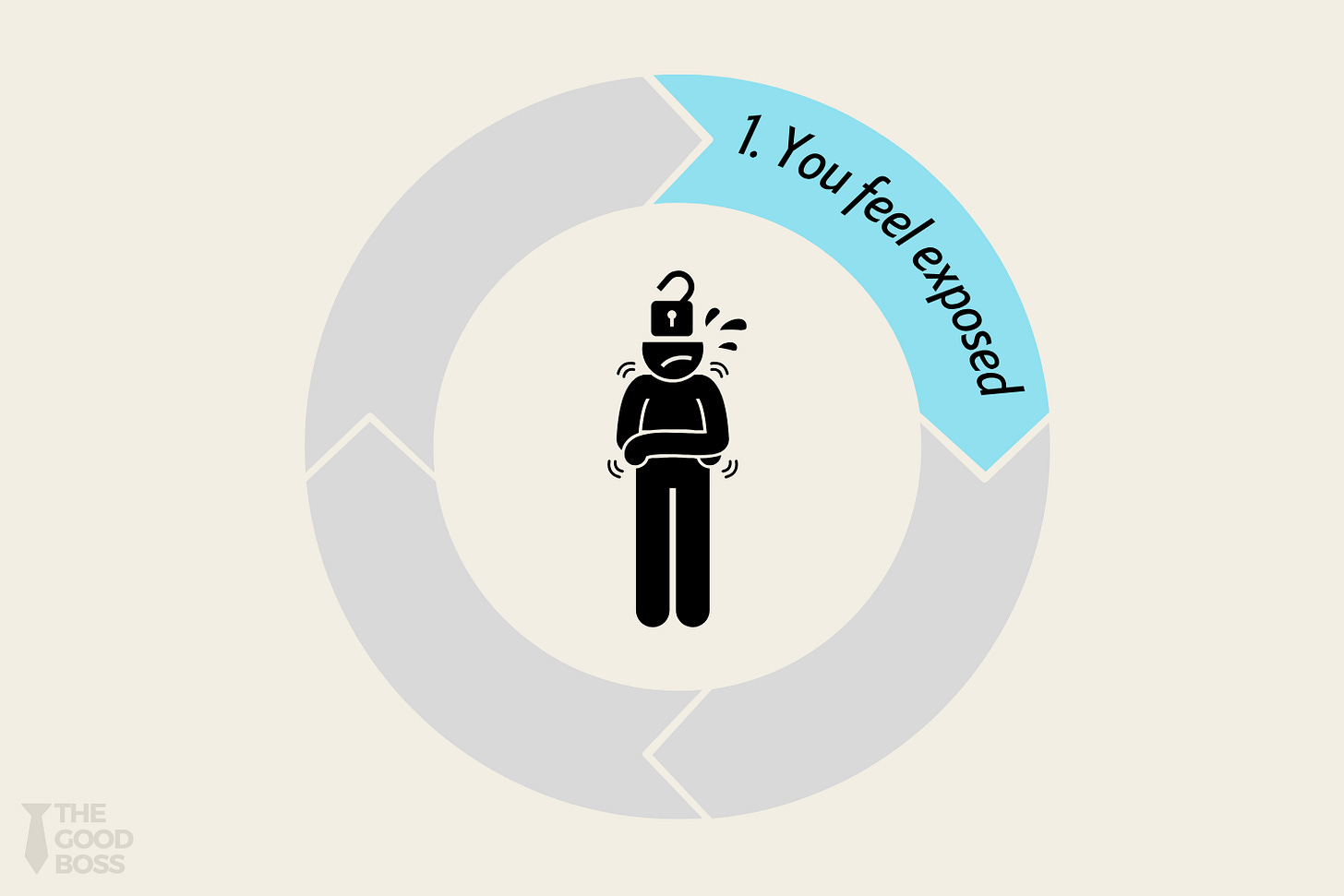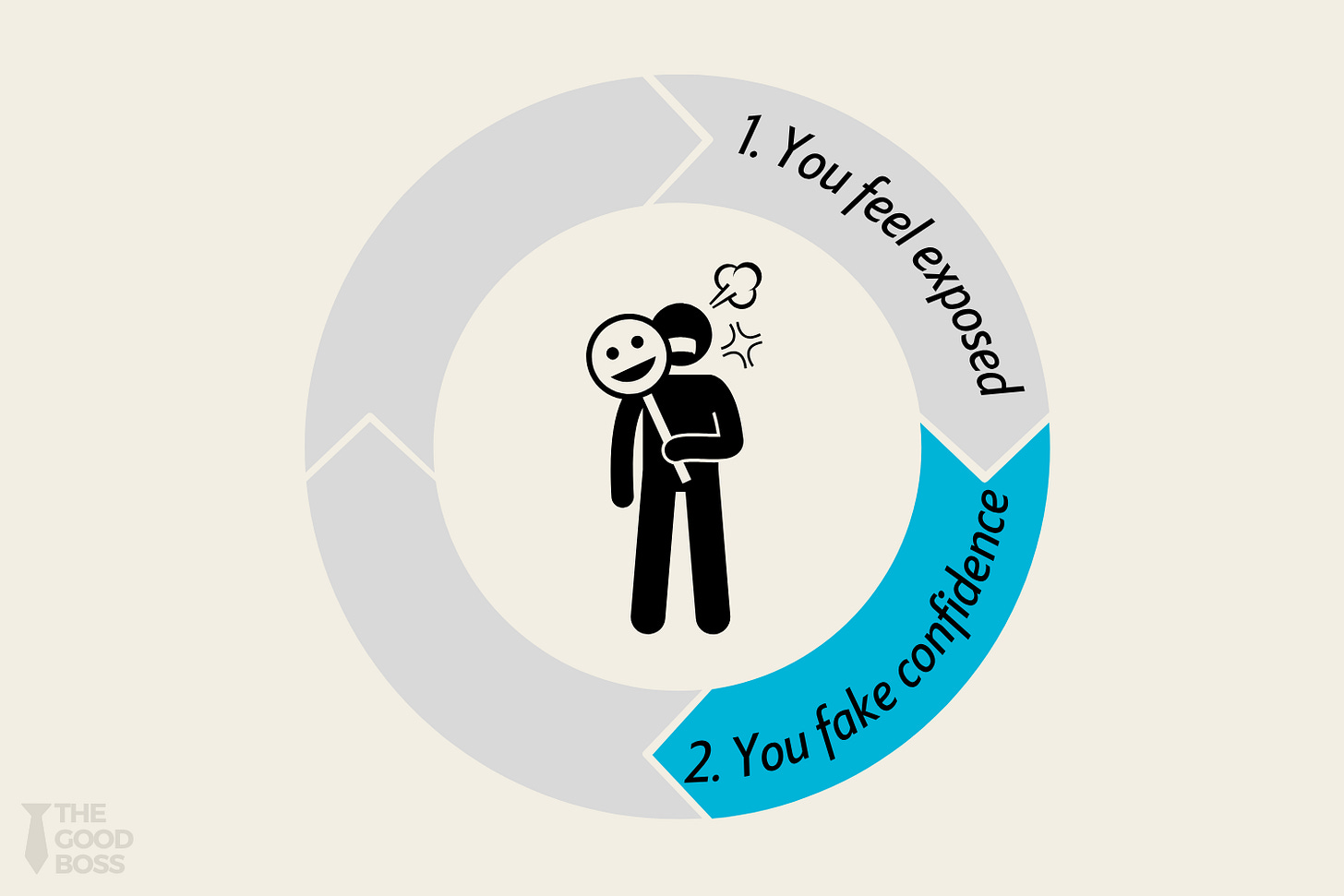Confident Outside, Scared Inside: The Insecurity Loop
How fear quietly shapes your leadership, and what to do about it
In this issue:
Part 1: Understanding Insecurity in Leadership
How Insecurity Disguises Itself: Ego, Shame, and Control
The Insecurity Loop
Part 2: Breaking Out of the Loop
The Loop Breaker Technique
Real-Life Leadership Scenarios
The Insecurity Loop Worksheet
Part 3: Going from here
Common Pitfalls and How to Avoid Them
Recommended Resources
Final Takeaway
✨
A few years ago, I was leading a platform transformation project at Autodesk. The project involved cross-functional teams across multiple geos. Add to that tight timelines and high visibility from above.
From the outside, it seemed like I was in control of the project. I had the polished slide decks for leadership, the detailed release plan for the team, and a confident posture in the meetings.
But deep inside me, a perfect storm was brewing:
Every time a team member or peer disagreed with my decision, I took it personally.
Every small delay in meeting an intermediate milestone felt like a judgment on my leadership.
Every update meeting with leadership became a performance.
It felt like I was walking on eggshells, yet nobody noticed, given how painstakingly hard I worked to paint a confident picture outside.
That moment opened my eyes to a painful truth, one I’ve seen in countless other leaders I coach and work with:
Most of the dysfunction we call “bad leadership” is about “unprocessed insecurity”, and less about “skill.”
According to a study published in Harvard Business Review, 69% of executives report struggling with impostor syndrome, even after years of “success”. And yet, they keep it hidden. What we see instead are the symptoms: micromanagement, ego, defensiveness, and burnout.
That’s what this article is about.
If you’ve ever:
Avoided a hard conversation because you didn’t want to look harsh
Overexplained in a meeting to sound like the smartest person in the room
Shut down or diverted feedback because it hit too close to home
Then chances are, you’re not a bad leader, you’re just stuck in what I call the Insecurity Loop.
Here’s a preview of what this loop looks like:
In the next few minutes, I’ll show you what the loop looks like, how it traps even experienced leaders, and the 4 steps that helped me (and many others) escape it.
Let’s get to it.
Part 1: Understanding Insecurity in Leadership
In this section, we will discuss a fundamental human emotion: insecurity. We will explore how insecurity can play a central role in leadership at all levels. We will learn about the Insecurity Loop, and how it can play havoc in leadership if not controlled.
How Insecurity Disguises Itself: Ego, Shame, and Control
Insecurity is a deep-rooted emotion, something we feel as leaders. It doesn’t really announce itself to the outside world.
Instead, insecurity typically disguises itself behind more visible behaviors and emotions. You can think of those as the ‘symptoms’, with insecurity being the ‘root cause’.
Based on my experience, the three most common ‘symptoms’ of deep-rooted insecurity in leadership are: ego, shame, and control.
Let’s unpack them one by one.
1. Ego: The Loud Cover-Up
When you lean on your ego, it tries to overcompensate for your underlying insecurity.
Here’s how it shows up:
You speak more than you listen
You try to sound like the smartest person in the room
You dismiss disagreement quickly
Ego makes you seem strong. But in reality, it breaks trust and repels people.
When your team feels your ego, they stop speaking up, stop sharing ideas, feedback, and even the truth. They do this not because they are intimidated by you, but because they can feel your insecurity.
2. Shame: The Quiet Withdrawal
Shame shows up when you turn the insecurity inward.
Here’s how it shows up:
You hide your mistakes
You constantly doubt your right to lead
You keep thinking: “I’m not good enough,” and “I don’t belong here.”
Shame makes you seem humble and grounded. But in reality, your team loses respect and confidence in you.
3. Control: The Gripping Reflex
Control is how many high-performing leaders manage their insecurity.
If you can own every detail, you can’t be blamed. So you’d think.
Here’s how it shows up:
You micromanage
You don’t trust others to step up
You take on too much, and then resent it
Control feels like competence, but in reality, it exposes your lack of trust. When you micromanage, you don’t let your team grow up to their potential, and end up making yourself the bottleneck.
The Insecurity Loop
The problem with the three disguises - ego, shame, and control - is that they’re weak and easily exposed.
What I have observed, both in my own experience, and in talking to leaders at various levels, is that ultimately insecurity and its various disguises form a loop. This is a predictable cycle that starts with insecurity, and ends with even more insecurity.
This is a loop that, once set in motion, feeds itself, almost like a vicious cycle.
I call this the Insecurity Loop. Here’s how it works.
Step 1: You Feel Exposed, Uncertain, or Not Enough
It starts with a moment of vulnerability.
A peer outperforms you
A project misses a milestone
A team member challenges your thinking
You step into a bigger role that stretches your limits
Suddenly, your sense of confidence wobbles. You feel shaky, insecure, exposed.
But instead of naming the feeling, you suppress it, because leadership has taught you that vulnerability is weakness.
👉🏼 So the fear goes underground. And that’s where the loop begins.
Step 2: You Fake Confidence, and react With Ego, Shame, or Control
Instead of sitting with the discomfort, you react by faking confidence using one of the three disguises we discussed earlier:
If you reach for ego, you double down on your authority
If you sink into shame, you withdraw or overcompensate
If you tighten with control, you take over everything and micromanage
These reactions make you feel safe, but only temporarily. They may protect you from feeling the fear for the moment, but they don’t solve the underlying problem or address the underlying emotion.
👉🏼 Every time you react instead of reflect, you give fear more power.
Step 3: Others React
This is where the cost starts to show. Your fake confidence attracts responses and reactions from others (including your team and stakeholders):
Your team hesitates to speak up
You burn yourself out trying to control everything
You create distance between yourself and others
Because of this distancing, the very things that would help, such as collaboration and trust, suffer and erode.
👉🏼 And guess what: that creates more stress, more disconnection, more fear.
Step 4: The Insecurity Deepens, and the Loop Tightens
With the incrased distancing of your team, your peers and stakeholders, the level of your insecurity deepens further:
You feel more isolated
You start reacting more, and reflecting less
You feel more and more trapped and stuck
👉🏼 Your level of insecurity deepens, and you feel trapped in your own cage.
The Vicious Cycle
And what do you do next?
You double down. More fake confidence, your team further distances itself, and you feel even more insecure.
Each cycle makes it harder to stop. Each spin of the loop reinforces the belief that you have to protect yourself, and that no one else can be trusted to help.
At its core, the insecurity loop emanates from “unprocessed insecurity” and becomes a vicious cycle that traps you.
So, how do you break out of this cycle or loop? We will discuss that next.
❤️ Enjoying the read? Subscribe to The Good Boss to get articles like this every week.
Part 2: Breaking Out of the Loop
In this section, you will learn how to break out of the Insecurity Loop in your role as a leader.
We will start by reviewing the Loop Breaker Technique, a 4-part model you can use to break the loop of insecurity.
We will then discuss some common real-life leadership scenarios, how the insecurity loop plays out in each of those scenarios, and how to counter them.
Finally, we will make it real with the Insecurity Loop Worksheet, which will help you build your muscle in managing insecurity in your leadership role.







